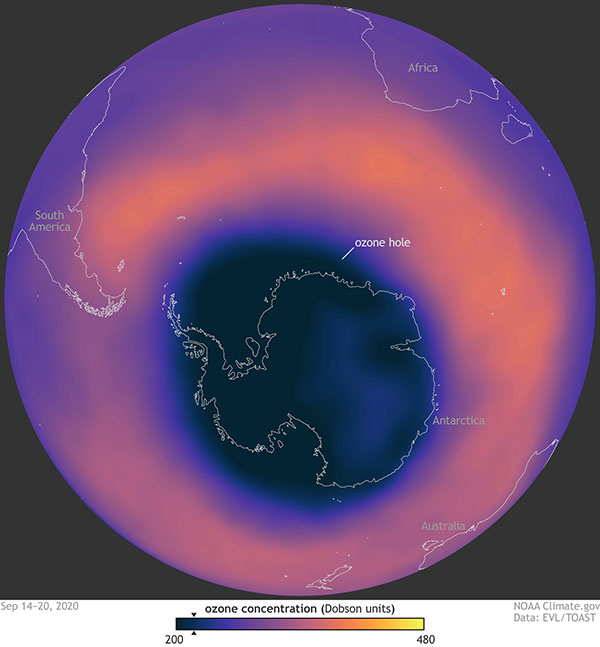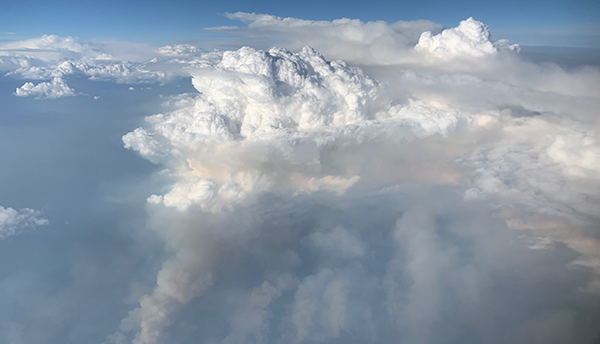A .gov website belongs to an official government organization in the United States.
A lock () or https:// means you've safely connected to the .gov website. Share sensitive information only on official, secure websites.
15 April 2021
adapted from the story by NOAA Communications

New research on the massive Australian bushfires in 2019 and 2020 shows that almost 1 million metric tons of smoke rose into the stratosphere, causing it to warm by about 1 degree Celsius for six months, and likely contributed to the large and persistent ozone hole that formed over Antarctica during the Southern Hemisphere's spring.
The 29 December 2019 – 4 January 2020 Australian New Year's wildfires were the most devastating in Australian history. They produced the largest input of wildfire smoke to the stratosphere observed in the satellite era, and had measurable effects on the atmosphere of the entire Southern Hemisphere.
Led by Pengfei Yu, a former CIRES scientist at CSL, a team of researchers used a climate model to study the transport, microphysics, chemistry, and climate impacts of smoke from the massive bushfires. They explored how extreme volumes of wildfire smoke can cause persistent impacts to the dynamics and chemistry of the stratosphere, which lies 12 to 50 kilometers (7 to 30 miles) above the surface, and contains the ozone layer that absorbs harmful ultraviolet radiation protecting life at the surface.
"Understanding stratospheric aerosols is crucial to understanding our climate," said Yu, now at the Institute for Environment and Climate Research at Jinan University in Guangzhou, China. "These massive high-altitude clouds of smoke serve as excellent opportunities to constrain and test our climate model for various purposes: understanding past, present and future climate associated with aerosols, as well as simulating the efficacy and climate implications of solar management strategies."
Wildfire smoke particles are mainly composed of organic carbon and black carbon. When black carbon particles absorb sunlight, the particles and the surrounding air heat and become buoyant, forcing that heated air parcel to loft to higher altitudes. The higher an air parcel rises, the longer it stays in the stratosphere, allowing the smoke aerosols to persist for months. Observations made by instruments on the International Space Station and on the NOAA/NASA JPSS satellite show that large amounts of smoke were lifted to 22 kilometers (more than 13 miles) in altitude within the first three months following the smoke injection.

Injecting particles in the stratosphere has been proposed as a way to reflect sunlight high in the atmosphere to reduce solar heating at the surface.
Particles similar to those emitted by large volcanoes are good reflectors of sunlight, and do not absorb a lot of solar energy. Smoke particles reflect sunlight, but they also absorb solar energy so they warm up the air very efficiently. In this case, the smoke reflected incoming sunlight, but did not produce a measurable cooling effect on the troposphere, the lowest layer of the atmosphere where surface weather is generated. It would take much more smoke to cool the troposphere than these fires injected, and that amount of smoke would have very large impacts on the stratosphere and the ozone layer, they said.
To that point, the modeling study estimated that chemical reactions initiated by the injected smoke caused a 4 to 6 percent loss in the protective ozone layer over Antarctica from August to December. The 2020 ozone hole was the third largest in the past decade and 18 percent larger than the 2010–2019 average.
Co-author Karen Rosenlof, part of a team of researchers from NOAA's Chemical Sciences and Global Monitoring Laboratories, CIRES, NCAR and the University of Colorado who worked on the paper, said that the study demonstrates that scientists are now able to model how smoke gets high into the stratosphere, where it can reside for a long time.
"What we don't understand well are possible impacts on surface weather and climate," said Rosenlof. "More work is needed to understand these feedbacks, because this is somewhat of a natural analog for impacts that could be caused by smoke-like aerosols that are emitted in the stratosphere from rockets, aviation, or by potential future geoengineering projects."
Yu, P., S.M. Davis, O.B. Toon, R.W. Portmann, C.G. Bardeen, J.E. Barnes, H. Telg, C. Maloney, X. Wang, and K.H. Rosenlof, Persistent stratospheric warming due to 2019-20 Australian wildfire smoke, Geophysical Research Letters, doi:10.1029/2021GL092609, 2021.
Australian wildfires burning from December 2019 to January 2020 injected approximately 0.9 Tg of smoke into the stratosphere; this is the largest amount observed in the satellite era. A comparison of numerical simulations to satellite observations of the plume rise suggests that the smoke mass contained 2.5% black carbon. Model calculations project a 1 K warming in the stratosphere of the Southern Hemisphere midlatitudes for more than 6 months following the injection of black‐carbon containing smoke. The 2020 average global mean clear sky effective radiative forcing at top of atmosphere is estimated to be −0.03 W m−2 with a surface value of −0.32 W m−2. Assuming that smoke particles coat with sulfuric acid in the stratosphere and have similar heterogeneous reaction rates as sulfate aerosol, we estimate a smoke‐induced chemical decrease in total column ozone of 10–20 Dobson units from August to December in mid‐high southern latitudes.